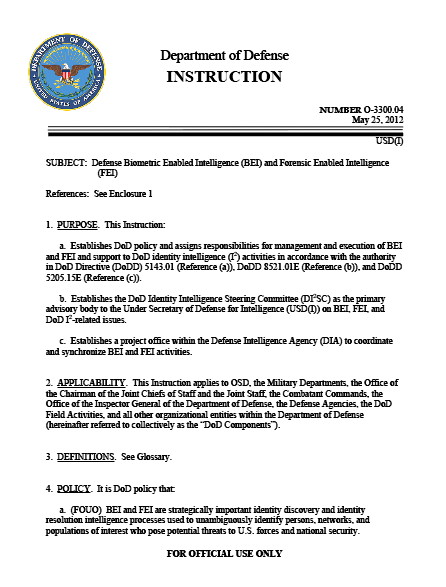The following instruction is part of a series of “limited release” DoD doctrine publications that are not released to the public.
DoD Instruction O-3300.04: Defense Biometric Enabled Intelligence (BEI) and Forensic Enabled Intelligence (FEI)
- 23 pages
- For Official Use Only
- May 25, 2012
1. PURPOSE. This Instruction:
a. Establishes DoD policy and assigns responsibilities for management and execution of BEI and FEI and support to DoD identity intelligence (I2) activities in accordance with the authority in DoD Directive (DoDD) 5143.01 (Reference (a)), DoDD 8521.01E (Reference (b)), and DoDD 5205.15E (Reference (c)).
b. Establishes the DoD Identity Intelligence Steering Committee (DI2SC) as the primary advisory body to the Under Secretary of Defense for Intelligence (USD(I)) on BEI, FEI, and DoD I2-related issues.
c. Establishes a project office within the Defense Intelligence Agency (DIA) to coordinate and synchronize BEI and FEI activities.
2. APPLICABILITY. This Instruction applies to OSD, the Military Departments, the Office of the Chairman of the Joint Chiefs of Staff and the Joint Staff, the Combatant Commands, the Office of the Inspector General of the Department of Defense, the Defense Agencies, the DoD Field Activities, and all other organizational entities within the Department of Defense (hereinafter referred to collectively as the “DoD Components”).
3. DEFINITIONS. See Glossary.
4. POLICY. It is DoD policy that:
a. (FOUO) BEI and FEI are strategically important identity discovery and identity resolution intelligence processes used to unambiguously identify persons, networks, and populations of interest who pose potential threats to U.S. forces and national security.
b. BEI and FEI shall be fully integrated into Defense Intelligence and the Defense Intelligence Component activities as an essential element of national security and in support of the full range of military operations consistent with national, defense, and operational priorities. BEI and FEI capabilities shall:
(1) Fuse BEI and FEI with associated contextual data and other available intelligence (e.g., document and media exploitation, signals intelligence (SIGINT), human intelligence (HUMINT)) to support irregular warfare (IW) in accordance with DoDD 3000.07 (Reference (d)), and counter human network operations that include counterterrorism, counterinsurgency, counterproliferation, counternarcotics, counterpiracy, and countersmuggling.
(2) Require coordination at all levels of operations, tactical to strategic, and between intelligence and criminal justice entities, to ensure the requisite depth of knowledge of current threats, while protecting intelligence sources and methods and criminal case integrity.
c. BEI and FEI policy, program, and technology development processes, and information management efforts shall be fully integrated with the DoD Biometric and Forensic Enterprises consistent with law and DoD policy and shall:
(1) Pursuant to References (b) and (c) control DoD biometric and forensic material and data collection, transmission, storage, caching, tagging, and use through DoD-approved national, international, and other consensus-based standards, protocols, best practices, and equipment to ensure consistency and support interoperability.
(2) Develop interoperability with other identity and intelligence information management capabilities and systems, both internal and external to the Department of Defense, to maximize effectiveness.
(3) Use BEI and FEI concepts and capabilities across all DoD activities including doctrine, organization, training, materiel, leadership and education, personnel, and facilities; policy; exercises; experiments; and applicable plans.
d. (FOUO) Effective BEI and FEI is an integral part of the DoD Biometric and Forensic Enterprises. In addition to the traditional intelligence cycle functions, BEI and FEI shall:
(1) Collect, digitize, and transmit biometric data at the tactical, operational, and strategic levels.
(2) Leverage non-intelligence (i.e., common and digital multimedia) forensics material, data, and processes for intelligence purposes consistent with Reference (c).
e. Collection, retention, and dissemination of U.S. person information shall be in accordance with Executive Order 12333 (Reference (e)), DoD 5240.1-R (Reference (f)), DoDD 5400.11 (Reference (g)), and DoD 5400.11-R (Reference (h)).
f. Nothing in this Instruction shall supersede the roles and responsibilities of the Heads of the DoD Components to exercise their authorities pursuant to References (b), (c), and DoDD 5105.21 (Reference (i)).

